While your main reason for staying in Roses may be the fantastic beaches, that isn’t the only reason for visiting.
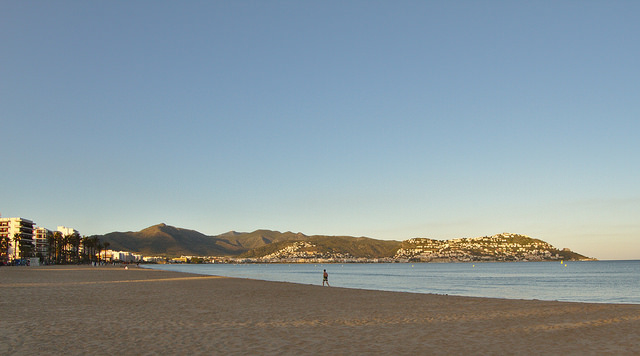
Bay of Roses at sunset. Photo by Dennis van Zuijlekom.
Roses has a history dating back to at least the fifth century BC when the Greeks arrived, perhaps even before. The Romans followed the Greeks, arriving in the second century BC. After the collapse of the Roman Empire it was the turn of the Visigoths.
Roses flourished during the middle ages when frequent pirate attacks resulted in extensive fortifications being built. Among the pirates to raid Roses was the infamous Turkish admiral known as Barbarossa, or “Redbeard”.
Despite the fortifications, Roses came under siege on four different occasions over the years. The town was last besieged in 1808 by French and Italian forces.
But it is only in the latter half of the twentieth century it developed into the tourist destination it is today. And one of the reasons Roses has remained popular for so many years a is its fantastic beaches.
From the long stretch of stand that extends from the town right down towards Empuriabrava to the smaller beaches and rocky coves on the Cap de Creus, there is a great choice. Pretty much something for everyone.
Anyway, below we’ll take a look at what you can see and do when you’re staying in Roses. Firstly in the town itself, then some things to do nearby and finally we’ll look further afield.
Roses town
Ciutadella de Roses
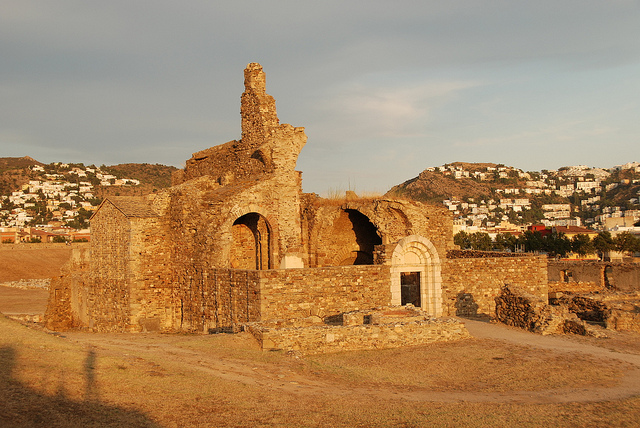
Santa Maria de Roses. Photo by Horrapics.
The Ciutadella de Roses was constructed in the mid-sixteenth century to defend the city from pirate raids and to protect the entire Bay of Roses from the French. Prior to that the site had been colonised by both the Greeks and the Romans.
Within the citadel are the ruins of Santa Maria de Roses, a partly restored Benedictine monastery. You’ll also find a museum within the defensive walls.
Castell de la Trinitat
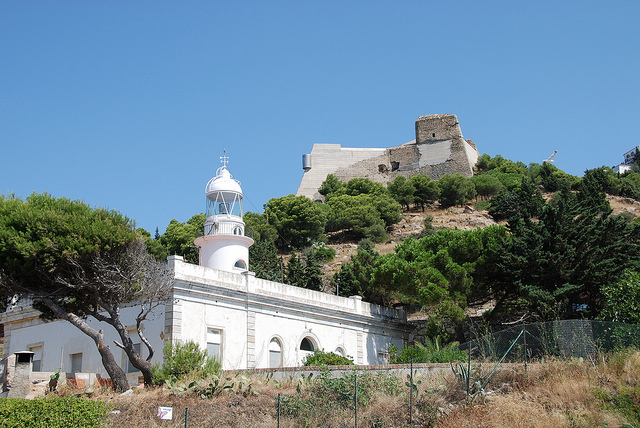
Castell de la Trinitat above the lighthouse. Photo by Horrapics.
Castell de la Trinitat dates from the mid-sixteenth century on the site of an earlier chapel from which the castle takes its name. It’s built on the headland overlooking the Bay of Roses.
During the month long Siege of Roses in 1808 the castle came under attack by against French and Italian infantry. It was defended by Royal Navy sailors supported by Catalan militia and regular forces but despite supporting bombardment from a number of British ships, the city eventually fell to the Franco-Italian troops.
Abandoned for two centuries, the castle was declared a site of cultural interest in 1988. In 2010 the castle and museum reopened to the public following extensive restoration.
Lighthouse
Just below Castell de la Trinitat is a neoclassic light house (see the above photo) which dates back to 1864. These days the lighthouse is fully automatic and operated from Barcelona. The cami de ronda coastal path passes in front of the lighthouse and from there you get a spectacular view of the Bay of Roses.
Air raid shelter
Like many towns in Catalonia, Roses was bombed during the Spanish Civil War (1936-1939). Because of this an air raid shelter was built for inhabitants to hide when being attacked.
Today the shelter is located in Plaça de la Pau (Peace Square) and while it isn’t open daily, there are occasional guided tours throughout the summer. Check this page for details.
Dolmen de la Creu d’en Cobertella
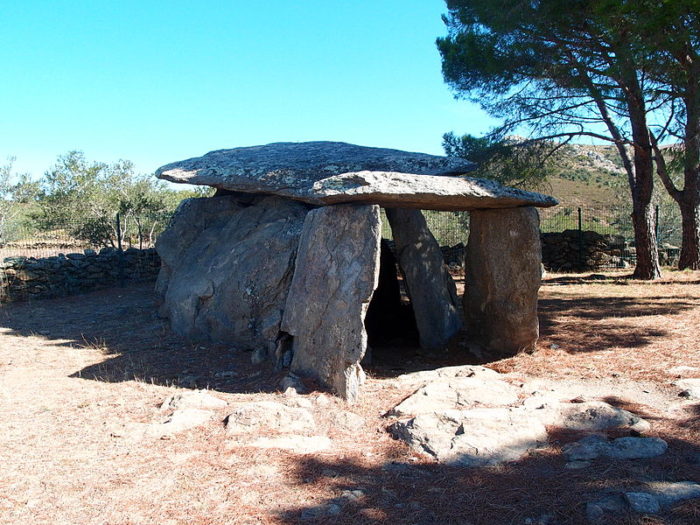
Dolmen de la Creu d’en Cobertella. Photo by Gordito1869.
There are a number of megalithic monuments to be found on the Cap de Creus but the dolmen de la Creu d’en Cobertella is the oldest in Catalonia. It is around a kilometre and a half from Roses town centre so easily accessible to anyone staying in the area.
The dolmen dates from around 3500 to 3000 BC and is just off the road between Roses and Montjoi. You’ll find it signposted and so relatively easy to find.
Santa Maria parish church
The church of Santa Maria dates from the end of the eighteenth century and while it was first used as a place of worship in 1796 before work was completed, the church was first completed in 1819. However, that wasn’t the end of the story. A high alter was added in 1839 and an extension added to the church between 1853 and 1857 but not finished.
Like many churches in Catalonia, Santa Maria was seriously damaged during the Spanish Civil War. In the second half of the twentieth century it underwent a series of restorations that finished in 1995.
Sunday market
A street market takes place every Sunday in Roses with up to 220 stalls selling food, clothes and souvenirs. The market is open between 09:00 and 13:00 near the ciutadella.
Activities
Diving

Scuba diving. Photo via Pixelbay.
The are two dive centres in Roses itself and another located at Cala Joncols. Each offers dive training with PADI or other internationally recognised dive organisations. Qualified divers can rent equipment and go on one of the many boat excursions along the coast. There are a host of dive sites on Cap de Creus and the water is often exceptionally clear making it one of the best places to dive in Spain.
Boat tour
One of the best ways to see the incredible Cap de Creus coastline is aboard one of the boat trips direct from Roses port. From here you’ll see some of the best coves on the Costa Brava. Some trips also go to Cadaqués or the Medes Islands.
Cadaqués
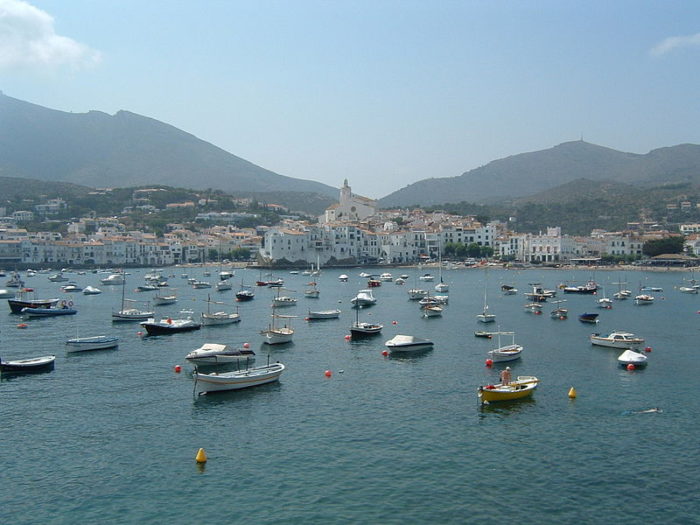
Cadaqués from the sea. Photo by Blacknight.
One of the northern Costa Brava’s most emblematic towns is easily reached from Roses. You can get there over the top of Cap de Creus by car or bus. Nearby is Portlligat and one of the three Salvador Dalí museums found in the Costa Brava area. It was formerly Dalí’s house and consists of a number of fishermen’s houses converted into a single larger property. From a distance the house is unmistakable for its typically Daliesque flourishes.
Sant Pere de Rodes
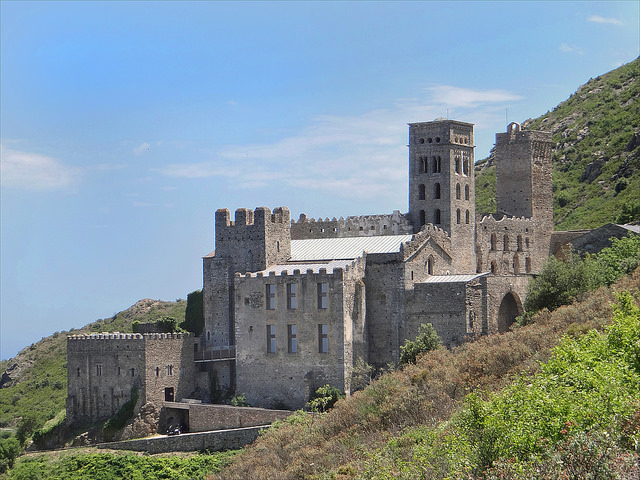
Sant Pere de Rodes monastery. Photo by Jean-Pierre Dalbéra.
High in the hills above Port de la Selva and Llançà is the monastery of Sant Pere de Rodes. Some of the oldest parts of the former benedictine monastery date from the eleventh century, with the Romanesque church dating from 1022. It has been recently restored and offers spectacular views.
Day trips
Girona
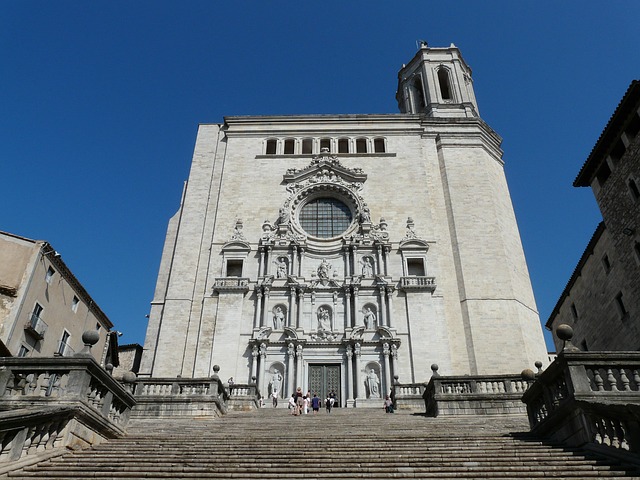
Girona’s gothic cathedral. Photo via Pixelbay.
Girona is the capital of the province of the same name and is rich with history. At 22 metres its cathedral boasts the widest Gothic nave in the world and the second widest of any church except St Peter’s Basilica. Also worth visiting is the Jewish quarter, the medieval city walls and the colourful houses along the river Onyar.
Game of Thrones fans will be thrilled that some scenes from season 6 were shot in Girona. In addition to that Girona is one of the main centres of professional cycling in Europe.
Figueres
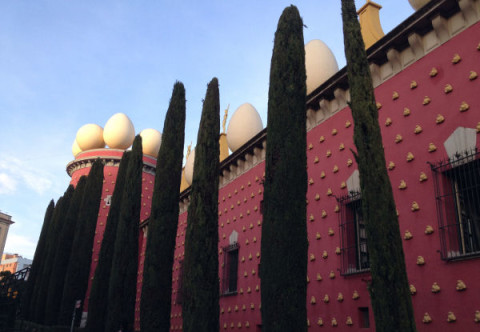
The Dalí museum in Figueres. Photo by David Leigh.
The principal town of the comarca of Alt Empordà is the birthplace of Salvador Dalí and home to the hugely popular Teatre-Museu Gala Salvador Dalí. The museum is definitely worth visiting.
Figueres is also where Narcís Monturiol was born. He invented the world’s first combustion engine-powered submarine. A replica of the submarine, Ictineo II, can be seen in Barcelona harbour.
Empúries
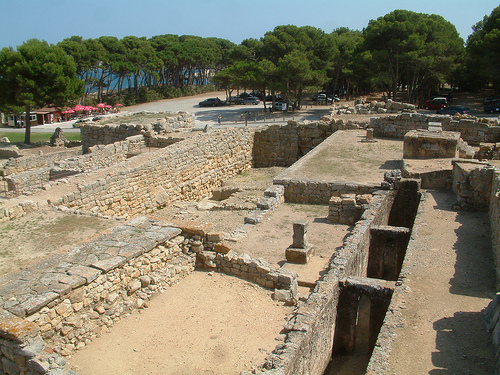
The ruins at Empúries. Photo by KaischiB.
Just next to L’Escala are the Greco-Roman ruins of Empúries. They represent one of the most important archaeological sites in Spain. Despite work on the site starting in the early twentieth century, it is estimated that around three-quarters of the site still remains to be investigated.
Barcelona

Barcelona’s Sagrada Família. Photo via Pixabay.
If you’ve exhausted all the possibilities offered by the Costa Brava or simply want to head for the big city, then Barcelona is fairly easy to get to. You can get there by car, by train or by bus but be warned. In summer Barcelona is unbearably hot.
Walk down the Ramblas, one of the city’s most iconic streets, or get on one of the many hop on/hop off tourist buses that ferries people between all the city’s best sites including Sagrada Família (above). And don’t forget that Barcelona is home to one of the biggest football clubs in the world. Even if there is no home match when you visit, the FC Barcelona museum is one of the most popular in the whole of Spain.

